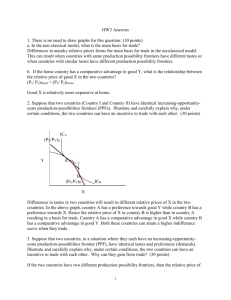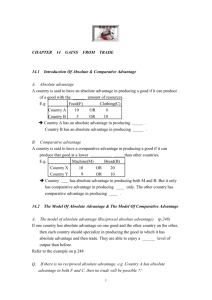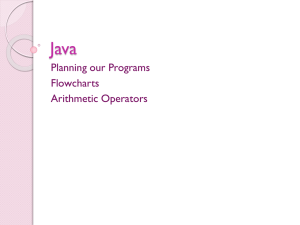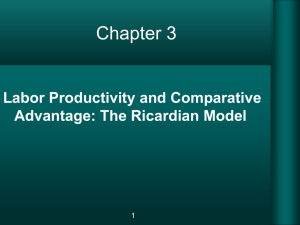PPT
advertisement
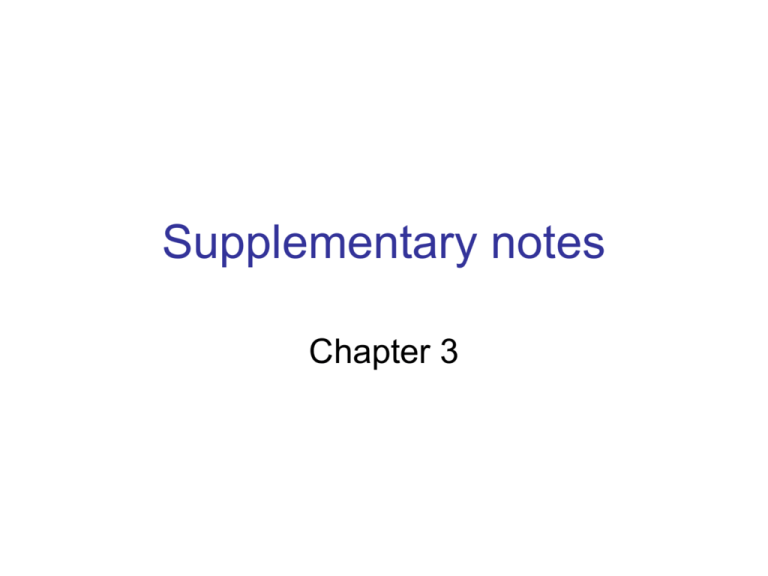
Supplementary notes Chapter 3 Unit Labor Requirements C W Home 1 2 Labor supply 120 Foreign 6 3 240 Opportunity cost • To increase C production by one unit, aLC hours are required. The resulting sacrifice in W production is aLC/aLW. • The opportunity cost of C in terms of W is ____ in Home. • In Foreign, the opportunity cost of C is ____. Relative price and Opportunity Cost • Before trade, the relative price of C to W is the same as the opportunity cost of C. Why? • Perfect competition No profits market price = production cost Pc = aLC W Pw = aLW W (W is the wage rate) Pc/Pw = aLC / aLW Absolute advantage and Comparative advantage • Home has absolute advantage in _____. • Foreign has absolute advantage in _____. • Home has comparative advantage in _____. • Foreign has comparative advantage in _____. Production Possibilities Frontier • Production possibilities for Home. 1 Qc + 2 Qw = 120 Qw = 60 – ½ Qc • Production possibilities for Foreign. Try! Production Possibilities Frontier • Draw the PPF for Home. Show that the (absolute value of the) slope is the same as the opportunity cost of C. • Do the same for Foreign. Terms of Trade • The terms of trade (ToT) is the relative price (PC / PW) in international trade. • ToT must be between the two OC’s. – In our example, Home’s OC (= 1/2) < Foreign’s OC (= 2) – What would happen if ToT is greater than 2? – (ToT may be equal to one of OC’s in extreme cases.) • Home’s OC (1/2) < ToT < Foreign’s OC (2) – PC / PW > aLC / aLW = aLCW / aLWW – PC / PW < a*LC / a*LW = a*LCW* / a*LWW* Pattern of production PC / PW > aLC / aLW • Meaning of this inequality? • Can you explain why Home will produce only cheese and there will be no production of wine? What if PC / PW = aLC / aLW? Consumption Possibilities Frontier • Assume ToT = 1. • For Home – At the above ToT, Home produces only C. On PPF, find the point of production after trade. – Find the maximum amount of W Home can buy with the amount of C. – Connect the two points. The resulting line is the CPF under trade. – Note CPF under autarky is the same as PPF. – This shows that trade expands the CPF. • Do the same for Foreign. Gains from trade 3 ways to show gains from trade A. Trade brings an expansion of production in the world as a whole. – Suppose that each country reduces the production of the good it has comparative disadvantage by 1 unit and moves saved resources to the good it has comparative advantage. Show what happens to the world production. B. Trade leads to an expansion of CPF. Gains from trade 3. For Home, it is cheaper to produce wine indirectly through trade than to produce it directly. – Direction production of wine costs 2 hours. – Indirect production of wine costs 1 hour if the ToT = 1. (To get 1W in trade requires 1C at the given ToT. 1C requires 1 hour of work in Home.) – Consider changes in real wages! ToT and Relative Supply • ToT is determined by relative supply (RS) and relative demand (RD). – Both RS and RD are “of C relative to W). • To find RS (supply of C relative to W): – – – – Remember OC < OC* in our case If ToT < OC, both countries will produce only ___. So the RS = 0. If ToT > OC*, both will produce only ___. So the RS . If OC < ToT < OC*, then each country produces the good in which it has comparative advantage. RS = ____. – If ToT = OC or OC*, the RS is indeterminate. • Why? • Consider the case where OC < ToT = OC*. • Home will produce only cheese. But Foreign will produce both. The exact amount of each good produced in Foreign depends on the demand condition. Determination of ToT • Relative demand is like usual demand. It is negatively sloping. • Each country’s production pattern and ToT are determined at the intersection of the RS and RD curves. • Show how the ToT changes in each of the following cases. – The demand for cheese declines. – The demand for wine increases . – Home’s production capacity shrinks as a result of a natural disaster. Wages and Productivities • In our example – aLC /a*LC = 1/6 – aLW /a*LW = 2/3 • Then W* / W cannot be lower than ___ and higher than ____. • What if W* / W < aLC /a*LC ? _____ Prices and Wages • In our example, • • • • – PC = aLCW – PW = a*LWW* (why?) From the above, PC / PW = aLCW / a*LWW* Rewrite and obtain W / W* = (a*LW /aLC) (PC / PW ) Home’s relative wage is higher – – – – The more productive is Home’s labor (smaller aLC) The less productive is Foreign’s labor (greater a*LW) The higher is the relative price of cheese or ToT. (Note the ToT is determined by RS and RD.) Exercises Unit labor requirements for two goods butter (B) and cheese (C) for two countries are given below: • France Germany • Butter 10 5 • Cheese 4 3 • Labor Supply 8000 6000 Exercises 1. Fill in blanks. a) Under autarky, the relative price of butter to cheese is ( ) in France. b) Germany has comparative advantage in ( ). c) ( ) has absolute advantage in cheese. d) If the German hourly wage rate is $30, the French wage rate cannot be higher than ( ). e) Draw the world relative supply curve for QB/QC. Exercises 2. Suppose that according to a report, 400 units of butter are traded for 800 units of cheese each period. a) What is the terms of trade? b) Which country exports butter? Cheese? c) Find the amounts of consumption of butter and cheese in France. d) In the following diagram for France, show and mark (i) “PPF” for the production possibility frontier, (ii) “CPF” for the consumption possibilities frontier, (iii) “P” for the production point in trade, and (iv) “C” for the consumption point. Use the X-axis for butter as indicated. Exercises 3. At the terms of trade mentioned in (2), if the German hourly wage rate is $30, the French wage rate should be ______. 4. Is trade illustrated above beneficial for France? Compare the cost of production of butter in direct production and indirect production.

